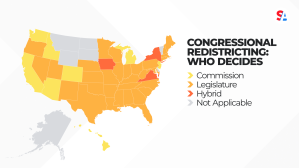
Bogan: ONE PERSON, ONE VOTE. IT’S A BASIC PRINCIPLE OF AMERICAN DEMOCRACY THAT GOES HAND IN HAND WITH EQUAL REPRESENTATION.
TO ENSURE THAT REMAINS, EVEN AS POPULATIONS GROW AND MOVE, POLITICAL MAPS ARE REDRAWN IN A PROCESS CALLED REDISTRICTING.
HERES HOW IT WORKS:
EVERY TEN YEARS, STATES ARE REQUIRED TO REDRAW MAPS FOR THEIR LEGISLATIVE AND CONGRESSIONAL DISTRICTS.
Hans A. von Spakovsky, Heritage Foundation Senior Legal Fellow: You can’t have weirdly shaped districts, they have to be compact, they have to be contiguous. Too often the lines have been drawn to try to divide voters up by race. I think it makes assumptions that kind of cast stereotypes.
Bogan: THIS IS DONE EITHER BY THE STATE LEGISLATORS THEMSELVES OR INDEPENDENT COMMISSIONS. BOTH HAVE BEEN ACCUSED OF DRAWING NEW MAPS TO GIVE ONE POLITICAL PARTY AN ADVANTAGE, OR GERRYMANDERING.
Hans A. von Spakovsky, Heritage Foundation Senior Legal Fellow: Whether it’s state legislators or an independent commission you’re probably going to get some gerrymandering, but at least state legislators are accountable to voters, commissions aren’t.
Bogan: THE TOP PRIORITY WHEN REDRAWING MAPS IS EQUAL POPULATION AMONG DISTRICTS SO EACH ELECTED OFFICIAL REPRESENTS ABOUT THE SAME NUMBER OF PEOPLE.
Yurij Rudensky, Brennan Center for Justice: “The goal is to have a congress, a house that represents the population as it currently is.”
Bogan: EQUAL REPRESENTATION IS A CONSTITUTIONAL REQUIREMENT, AFFIRMED BY THE SUPREME COURT IN THEIR 1964 DECISION WESBERRY V. SANDERS.
JUSTICE HUGO BLACK WROTE FOR THE MAJORITY: “To say that a vote is worth more in one district than in another would not only run counter to our fundamental ideas of democratic government, it would cast aside the principle of a House of Representatives elected ‘by the People,’…”
NEW MAPS ARE BEING DRAWN RIGHT NOW USING DATA FROM THE 2020 CENSUS WHICH REVEALED POPULATION GROWTH ADVANTAGEOUS TO RED STATES.
AS A RESULT – FLORIDA, MONTANA, AND NORTH CAROLINA EACH GAINED ONE SEAT IN CONGRESS, TEXAS GAINED TWO.
DEMOCRATIC STRONGHOLDS CALIFORNIA, ILLINOIS AND NEW YORK EACH LOST ONE.
AS REDISTRICTING CONTINUES, MEMBERS OF BOTH PARTIES ARE ACCUSING EACH OTHER OF GERRYMANDERING.
IN ILLINOIS, REPUBLICANS ARE ACCUSING THE DEMOCRATIC CONTROLLED LEGISLATURE AND GOVERNOR OF PURPOSEFULLY ERASING SOME GOP DISTRICTS TO FORCE INCUMBENTS TO RUN AGAINST EACH OTHER FOR FEWER SEATS.
THE STATE REPUBLICAN CHAIRMAN STATED:
“Democrats are back at it again disenfranchising voters and putting politicians before the people of Illinois.”
Bogan: HOURS AFTER THE NEW ILLINOIS MAPS WERE RELEASED, CONGRESSMAN ADAM KINZINGER ANNOUNCED HE’LL RETIRE AT THE END OF HIS TERM. IF HE STAYED, HE WOULD HAVE BEEN FORCED INTO A PRIMARY AGAINST A FELLOW REPUBLICAN CONGRESSMAN.
Congressman Adam Kinzinger says: “My disappointment in leaders who don’t lead is huge.”
Bogan: IN TEXAS, A NON-PROFIT AND 13 RESIDENTS ARE SUING THE REPUBLICAN GOVERNOR AND SECRETARY OF STATE.
THE SUIT SAYS THE NEW MAP QUOTE “dilutes the voting power of Texas’s Latino and Black communities”
BUT SOME EXPERTS SAY THE DEMOGRAPHICS AREN’T BLACK AND WHITE.
Wasserman says: “Keep in mind that hispanic voters in Texas shifted by double digits from Clinton to Trump between 2016 and 2020. “
Bogan: IT’S IMPORTANT TO NOTE THAT MANY NEW MAPS HAVE NOT BEEN SIGNED INTO LAW JUST YET, AND ARE SUBJECT TO FURTHER DEBATE AND LEGAL CHALLENGES.
SO WHAT DO YOU THINK ABOUT OUR COUNTRY’S REDISTRICTING PROCESS AND THE CURRENT CYCLE? LET US KNOW IN THE COMMENTS BELOW, AND DON’T FORGET TO CLICK THE STRAIGHT ARROW BIAS METER.







